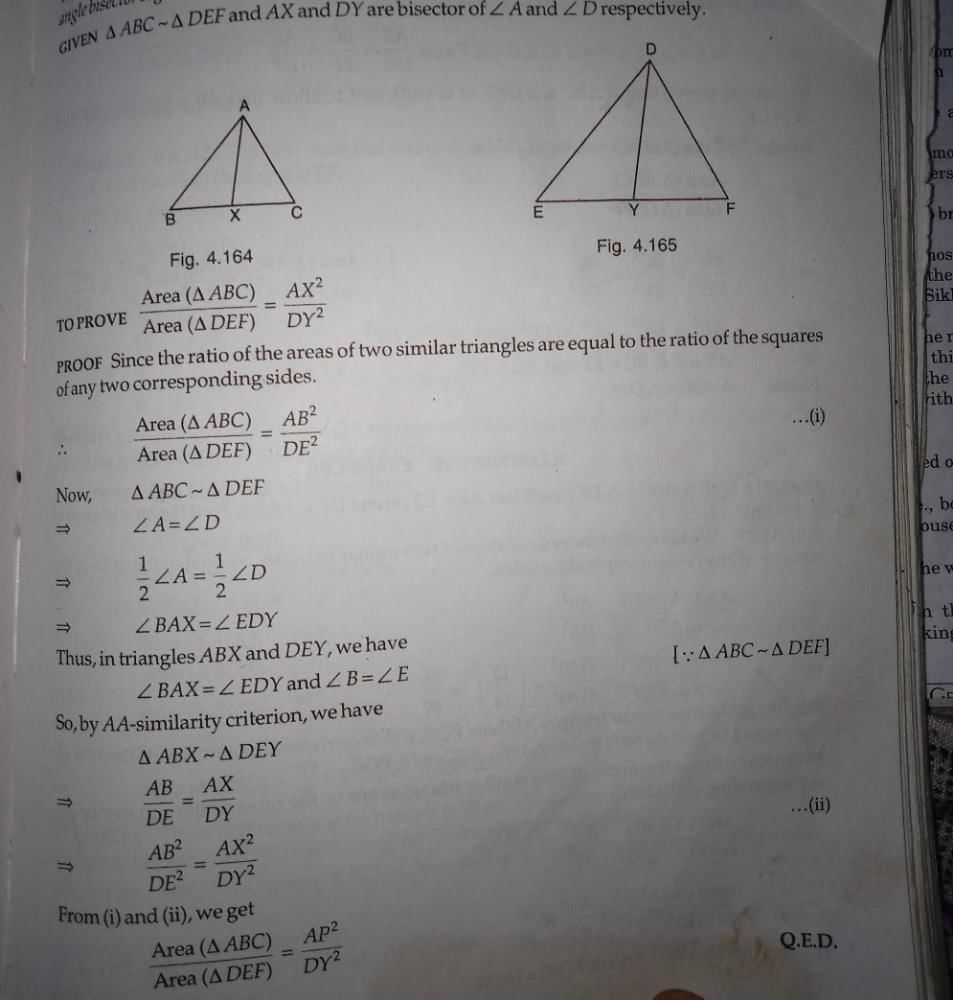Class 10 Exam > Class 10 Questions > Prove that the areas of two similar triangles...
Start Learning for Free
Prove that the areas of two similar triangles are in the ratio of the square of the corresponding angle bisector segment?
Most Upvoted Answer
Prove that the areas of two similar triangles are in the ratio of the ...

Community Answer
Prove that the areas of two similar triangles are in the ratio of the ...
Proof of the Ratio of Areas of Similar Triangles
How are the areas of two similar triangles related to the square of the corresponding angle bisector segment? Let's prove it step by step.
1. Setting Up the Triangles
Consider two similar triangles, ΔABC and ΔDEF, where ∠A = ∠D, ∠B = ∠E, and ∠C = ∠F. Let AD and BE be the angle bisectors of these triangles, intersecting at point O.
2. Finding the Ratios of the Areas
Since ΔABC ~ ΔDEF, we have:
AB/DE = AC/DF = BC/EF
Now, let's focus on the ratio of the areas of these triangles. The area of a triangle is given by the formula:
Area = 1/2 * base * height
3. Applying the Area Formula
For ΔABC, the height corresponding to base BC is the length of the angle bisector AD, which we can denote as h1. So, the area of ΔABC is:
Area(ΔABC) = 1/2 * BC * h1
Similarly, for ΔDEF, the height corresponding to base EF is the length of the angle bisector BE, which we can denote as h2. So, the area of ΔDEF is:
Area(ΔDEF) = 1/2 * EF * h2
4. Comparing the Ratios of the Areas
Now, we need to compare the ratio of the areas of ΔABC and ΔDEF:
Area(ΔABC)/Area(ΔDEF) = (1/2 * BC * h1) / (1/2 * EF * h2)
Simplifying this expression, we get:
Area(ΔABC)/Area(ΔDEF) = (BC/EF) * (h1/h2)
Since BC/EF = AB/DE (from the similarity of the triangles), we have:
Area(ΔABC)/Area(ΔDEF) = (AB/DE) * (h1/h2)
5. Conclusion
From the above derivation, we can see that the ratio of the areas of two similar triangles is indeed equal to the square of the corresponding angle bisector segments. This relationship holds true for any pair of similar triangles with angle bisectors intersecting at a point.
Attention Class 10 Students!
To make sure you are not studying endlessly, EduRev has designed Class 10 study material, with Structured Courses, Videos, & Test Series. Plus get personalized analysis, doubt solving and improvement plans to achieve a great score in Class 10.

|
Explore Courses for Class 10 exam
|

|
Similar Class 10 Doubts
Prove that the areas of two similar triangles are in the ratio of the square of the corresponding angle bisector segment?
Question Description
Prove that the areas of two similar triangles are in the ratio of the square of the corresponding angle bisector segment? for Class 10 2024 is part of Class 10 preparation. The Question and answers have been prepared according to the Class 10 exam syllabus. Information about Prove that the areas of two similar triangles are in the ratio of the square of the corresponding angle bisector segment? covers all topics & solutions for Class 10 2024 Exam. Find important definitions, questions, meanings, examples, exercises and tests below for Prove that the areas of two similar triangles are in the ratio of the square of the corresponding angle bisector segment?.
Prove that the areas of two similar triangles are in the ratio of the square of the corresponding angle bisector segment? for Class 10 2024 is part of Class 10 preparation. The Question and answers have been prepared according to the Class 10 exam syllabus. Information about Prove that the areas of two similar triangles are in the ratio of the square of the corresponding angle bisector segment? covers all topics & solutions for Class 10 2024 Exam. Find important definitions, questions, meanings, examples, exercises and tests below for Prove that the areas of two similar triangles are in the ratio of the square of the corresponding angle bisector segment?.
Solutions for Prove that the areas of two similar triangles are in the ratio of the square of the corresponding angle bisector segment? in English & in Hindi are available as part of our courses for Class 10.
Download more important topics, notes, lectures and mock test series for Class 10 Exam by signing up for free.
Here you can find the meaning of Prove that the areas of two similar triangles are in the ratio of the square of the corresponding angle bisector segment? defined & explained in the simplest way possible. Besides giving the explanation of
Prove that the areas of two similar triangles are in the ratio of the square of the corresponding angle bisector segment?, a detailed solution for Prove that the areas of two similar triangles are in the ratio of the square of the corresponding angle bisector segment? has been provided alongside types of Prove that the areas of two similar triangles are in the ratio of the square of the corresponding angle bisector segment? theory, EduRev gives you an
ample number of questions to practice Prove that the areas of two similar triangles are in the ratio of the square of the corresponding angle bisector segment? tests, examples and also practice Class 10 tests.

|
Explore Courses for Class 10 exam
|

|
Suggested Free Tests
Signup for Free!
Signup to see your scores go up within 7 days! Learn & Practice with 1000+ FREE Notes, Videos & Tests.

























